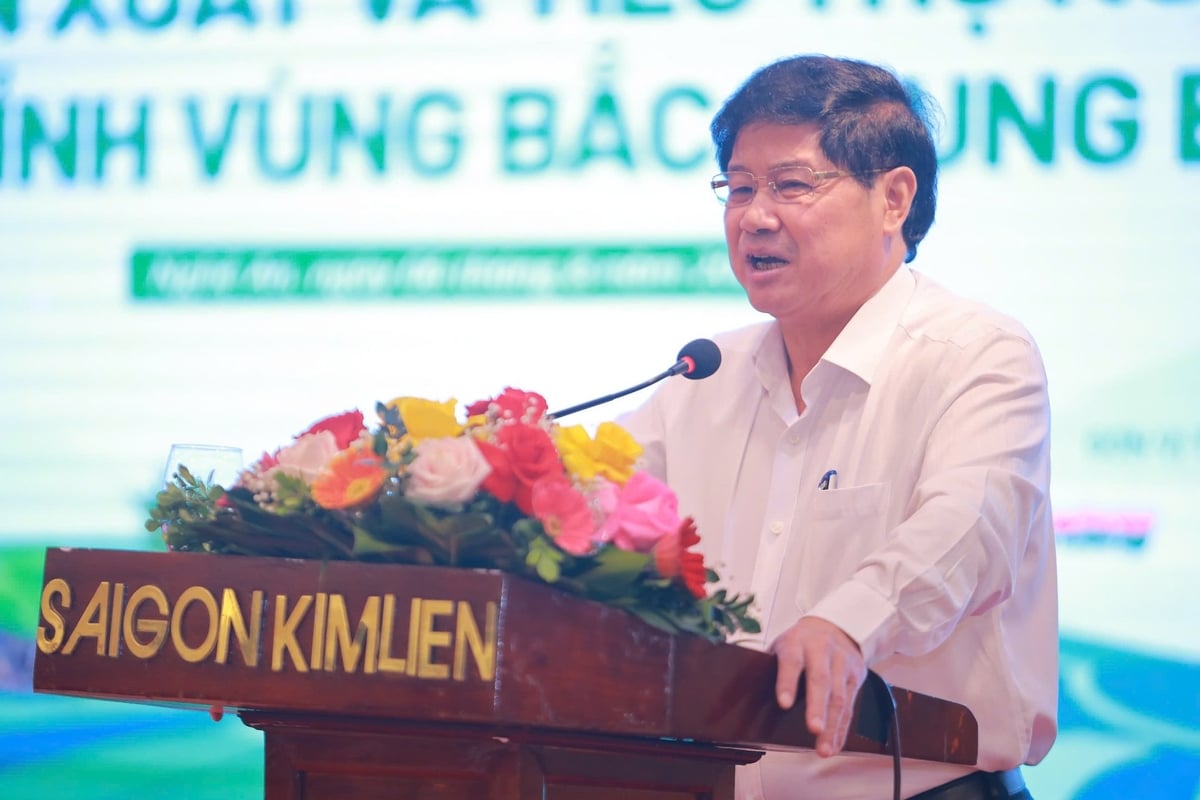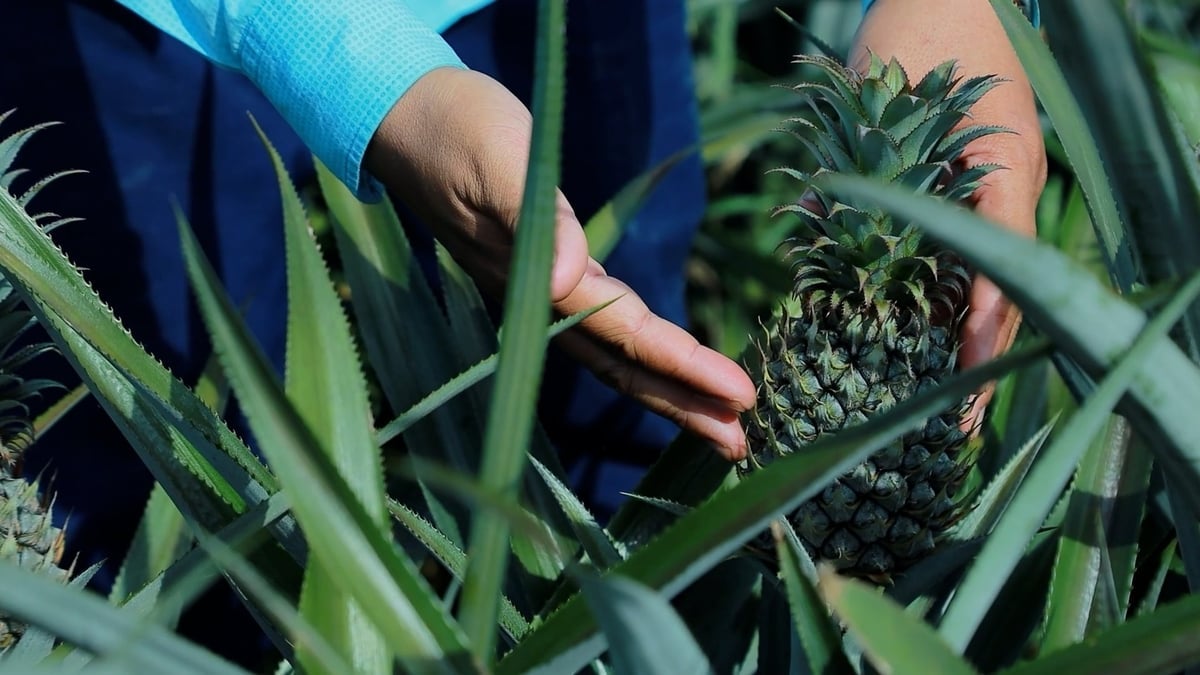November 19, 2025 | 13:52 GMT +7
November 19, 2025 | 13:52 GMT +7
Hotline: 0913.378.918
November 19, 2025 | 13:52 GMT +7
Hotline: 0913.378.918
According to Assoc. Prof. Dr. Le Quoc Doanh, former Deputy Minister of Agriculture and Rural Development and Chairman of the Vietnam Gardening Association, the North Central region, particularly Nghe An and neighboring provinces, possesses ideal conditions for pineapple cultivation, especially the MD2 variety.
“The drier the weather, the higher the Brix level. Pineapples are drought-tolerant, resistant to storms, and can be grown almost organically,” he explained, emphasizing that the very harsh climate, if properly harnessed, could become a competitive advantage. Dr. Doanh noted that pineapple is one of the few fruit crops that thrive in prolonged hot and dry conditions, which are typical of the North Central region.

Assoc. Prof. Dr. Le Quoc Doanh, former Deputy Minister of Agriculture and Rural Development, and Chairman of the Vietnam Gardening Association. Photo: VAN.
In terms of market demand, pineapple enjoys strong consumption both domestically and internationally. However, a longstanding concern among farmers has been securing stable buyers. According to Dr. Doanh, this challenge is gradually being addressed as Dong Giao Export Food Joint Stock Company (Doveco) has committed to long-term investment and partnership with the region.
“I feel particularly reassured by Doveco’s investment here. It is a professional enterprise with a well-established processing ecosystem,” Dr. Doanh said at the North Central Provinces’ Agricultural Production and Consumption Connection Forum, organized by Vietnam Agriculture and Nature Newspaper in collaboration with the Vietnam Gardening Association, the National Agro-Forestry-Fisheries Quality Assurance Department, the Plant Production and Protection Department, and the Nghe An Department of Agriculture and Environment, under the direction of the Ministry of Agriculture and Environment.
If the cultivation area is expanded, Dr. Doanh believes pineapple could very well become the region's next “billion-dollar crop.”
Unlike seasonal fruits such as oranges, longans, or mangoes, pineapples can be grown and harvested year-round, offering a significant advantage for export. Therefore, Dr. Doanh believes that choosing pineapple as a key crop is a sound direction, provided local authorities and farmers adopt a long-term strategy that links production with enterprises and market demand.
Sharing the view on expanding pineapple cultivation in the North Central region, Ms. Bui Thi Hong Ha from the Center for Organic Agriculture Promotion and Studies (Vietnam National University of Agriculture) expressed concern that while farmers are increasing their pineapple planting areas, sustainable consumption solutions have yet to be fully developed.
According to Ms. Ha, pineapple has many advantages for development in the North Central provinces, especially on lands converted from low-efficiency rice fields or upland areas lacking irrigation. It is a crop well-suited to dry conditions and can generate higher income compared to rice or short-term industrial crops. However, the transition must be sustainable, avoiding spontaneity and ensuring strong linkages between growers and processing or export enterprises.
Despite its potential, if pineapple cultivation is not connected to the market, farmers risk falling into the trap of “bumper crop, falling prices.” Many households grow pineapple based solely on experience and limited technical knowledge, leading to inconsistent quality that struggles to meet the standards of official export chains.
Based on this reality, Ms. Ha emphasized the need for enterprises to invest in raw material zones for those transitioning to pineapple in order to establish strong incentive policies and necessary infrastructure such as warehouses and transport systems.

Pineapple is especially well-suited to dry climates. Photo: VAN.
In addition to pineapple, former Deputy Minister of Agriculture and Rural Development Le Quoc Doanh emphasized that tea and citrus, once considered strengths of the region, are now facing significant challenges. However, with proper investment and direction, these crops still hold considerable potential.
Citrus crops such as oranges and tangerines have seen a sharp decline due to pest and disease pressures, particularly citrus greening disease (also known as huanglongbing or HLB). This disease has led to the destruction of many orchards in recent years. “The main causes are varietal degeneration and the lack of an effective disease management protocol,” Dr. Doanh noted.
In response, the Vietnam Gardening Association has proactively sought technical collaboration with Australia, a country with extensive experience in combating citrus greening disease, to secure support for a technical project. The project will provide disease-free planting materials and introduce adaptive cultivation practices aimed at revitalizing the citrus industry in the North Central region.
As for tea, the region already has over 10,000 hectares under cultivation, yet the economic returns remain far below its potential. “Fresh tea buds can generate up to 400 million VND per hectare (approximately 15.250 USD), and if processed into black tea, the value could double. However, in reality, average income from tea in the North Central region is only about 50 to 60 million VND per hectare (around 1.900 - 2.290 USD) - far too low,” Dr. Doanh observed.
He attributed this limitation to the fact that many localities have not prioritized renewing tea varieties, cultivation techniques, or processing technologies. Some provinces have recently begun restructuring their tea varieties and seeking market-oriented directions better aligned with both domestic consumption and export opportunities.
He suggested that provinces should organize study tours to learn from tea cultivation and processing models in Thai Nguyen - a locality that has been successful in enhancing the value of tea through strong linkages between production, processing, and consumption, tied closely to brand building.
Based on these observations, Dr. Doanh emphasized that unlocking the agricultural potential of the North Central region requires a shift in mindset toward methodical investment and the development of close cooperation among the “four stakeholders”: farmers, scientists, businesses, and local authorities.
“Harsh climate conditions are not a weakness if people know how to adapt. The greater the challenge, the more we must think differently. That’s an opportunity to rise through our distinct advantages,” he concluded.
Nguyen The Trung, former Party Secretary of Nghe An Province, shared that coconut and pineapple are two agricultural products with large and stable year-round markets. While the southern region has many advantages for coconut cultivation, the northern region holds strong potential for expanding pineapple production, thanks to favorable climate and soil conditions.
Mr. Trung emphasized the critical role of the agro-processing industry, not only as a growth driver but also as a key link connecting different localities. However, he noted that returns on investment in agricultural processing are not immediate; it typically takes 6 to 7 years to fully assess the effectiveness. This depends heavily on natural factors such as land availability, a stable supply of raw materials, and environmental sustainability.
Therefore, building a processing facility without securing a reliable source of raw materials is highly risky. He expressed concern that many localities still face the challenge of how to attract businesses to invest in deep processing, enhance product value, and improve farmers’ incomes.
Translated by Phuong Linh

(VAN) Deputy Minister Nguyen Thi Phuong Hoa calls for prioritizing the livelihoods of coastal residents, particularly those impacted by marine economic development projects.

(VAN) People can now submit their land-use right certificates ('red books') via the VNeID application. This marks an essential step toward fully paperless public services in land administration in the near future.

(VAN) Fishermen and authorities in Khanh Hoa province are demonstrating strong resolve in the fight against IUU fishing, aiming to develop a sustainable fisheries sector and remove the European Commission's (EC) ‘yellow card.’

(VAN) Viet Nam has declared that it will develop and implement strong greenhouse gas reduction measures to achieve Net Zero emissions by 2050 and it is following through on that commitment.

(VAN) A comprehensive legal framework, tailored to domestic conditions, serves as the foundation guiding economic sectors toward low-emission development.

(VAN) Mastering technical skills and leveraging the advantages of Dau Tieng Lake, residents of Loc Ninh have created a sustainable pathway out of poverty.

(VAN) The entire political system of Dak Lak is taking strong and synchronized action against IUU fishing. The province has achieved a 100% rate of installing VMS on vessels over 15 meters in length.